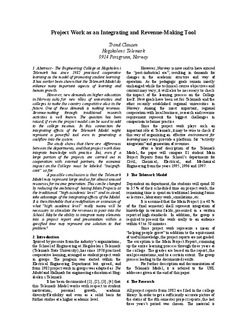Project work as an integrating and revenue-making tool
Conference report

Åpne
Permanent lenke
http://hdl.handle.net/11250/2438405Utgivelsesdato
1998Metadata
Vis full innførselSamlinger
Originalversjon
Conference paper. International Conference on Engineering Education. Rio de Janeiro, August 17-20, 1998.Sammendrag
The Engineering College at Høgskolen i Telemark has since 1982 practised cooperative learning as the model of promoting student learning. It has earlier been shown that the Telemark Model do enhance many aspects of learning and human growth. However, new demands on higher education in Norway asks for new roles of universities and colleges to make the country competitive also in the future. One of these demands is making revenues. Revenue-making through traditional research activities is well known. The question has been raised, if even the project model can be used to add to the college incomes. In this connection the integrating effects of the Telemark model might represent a powerful tool even in generating a cashflow into the system. The study shows that there are differences between the departments, and that project work does integrate knowledge with practice. But, even if a large portion of the projects are carried out in cooperation with external partners, the economic impact on the College must be labeled "insignificant" so far. A possible conclusion is that the Telemark Model may represent large and so far almost unused resources for income generation. This can be changed by reducing the ambition of having Main Projects at the traditional "high academic level" and in stead, take advantage of the integrating effects of the Model. It is then thinkable that a redefinition or extension of what "high academic level" really means will be necessary to stimulate the revenues to pour into the School. Maybe the ability to integrate many elements into a project report and a presentation within a specified time may represent one solution to that problem?